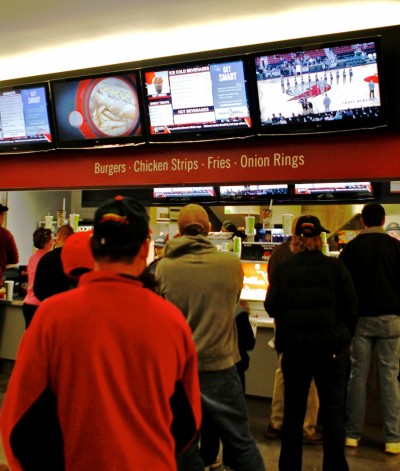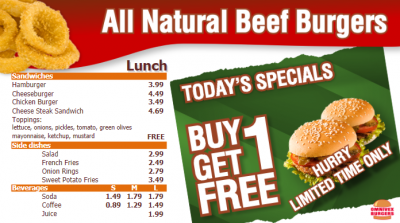Improving efficiency
Indeed, while digital menu boards may require a more sizable investment at the outset than traditional static displays, the long-term payoff can be substantial.
For one thing, content creation and distribution can be centrally managed at the corporate level. One employee at a head office can develop and send out content to hundreds of different restaurants, reducing the local burden of installing and changing out backlit signs. Large-scale changes to promote new products or update caloric information can be handled instantly. All of this helps save time and drives down labour costs.

Digital menu boards can cycle through video clips to ensure customers in line see as much different content as possible, which has been shown to reduce their perceived waiting time.
The same benefits can be applied to marketing and promotional activities, particularly for large, franchised restaurant chains. In the past, new materials would need to be created, distributed to various locations, reported on and discarded. This process required significant time and effort, with costs associated with developing content for and printing posters and backlit signs. Additionally, if these pieces were ever late getting to or being installed at one of their destinations, there was a loss of promotional opportunity.
With the advent of digital menu boards comes the ability to distribute new content instantaneously, without the need to ship, install or dispose of physical materials for each promotional campaign. A new menu item can be test-marketed at select locations with ease, requiring no additional costs or time, aside from that involved in creating the new content. The head office can also retrieve and analyze results of the campaign immediately.
An example would be a fast-food chain simultaneously promoting regular fries at one location and curly fries at another, to see if customers are more receptive to one than the other.
In today’s economic environment, where budgets are tight and expectations are high, these methods for reducing costs, streamlining processes and improving the bottom line have been key in driving the implementation of new digital signage systems.
Expanded functionality
In the past, with static signage featuring new menu items and promotions, it was difficult to keep all of this information up-to-date. In-store specials and pricing might change weekly or even daily, so it was nearly impossible to ensure all displays remained relevant. By the time a particular franchise in a restaurant chain was notified of a menu change, the process of receiving new artwork and replacing old content often used up valuable promotional time.
Digital menu boards, on the other hand, can integrate real-time data into on-screen content. They can connect to companies’ existing data resources, such as point-of-sale (POS) systems, to reflect changes instantly.

Quick-service restaurants (QSRs) may change their in-store specials weekly or even daily, so digital signage can prove highly valuable by integrating real-time data into on-screen content.
This functionality is also valuable when QSRs vary their menus depending on the time of day. Digital signs can be updated to showcase breakfast, lunch and dinner items. Gone are the days when in-store employees had to change out the menu boards manually; now they can focus on their key job functions with regard to serving customers.
Other factors can also be used as triggers for dynamic content. At downtown Toronto’s Air Canada Centre (ACC), a stadium owned by Maple Leaf Sports & Entertainment (MLSE), beer provider Molson Coors catches fans’ attention with digital signage by changing the colour of its displayed mountain logos based on temperature. This feature reflects a recent marketing campaign, where the same logos on product labels changed colour when the drinks reached their ideal cold temperature. It also takes advantage of the ACC’s facility-wide digital signage network (see Sign Media Canada, September 2012, page 42), which was designed with ambient environmental effects in mind, as a way to create unique and memorable experiences for visitors.
Menu layouts may also vary depending on specific displays’ locations and configurations. A good example of this type of difference is between the content for in-store and drive-thru menu boards. Outdoor boards generally need to be positioned differently, due to space restrictions, with information spread across one or two narrow, vertical screens. Rather than having to redesign all content for outdoor and indoor use, digital signage content management software allows the ‘core’ layout to be developed once, then reused in multiple configurations.
Some chains develop menus with slight variations for different franchises. This could be extremely labour-intensive, but by breaking content down into components and then building up dynamic menus as a combination of these parts, digital signage can generate a large number of variations with very little work.
Another benefit of digital menu boards is improved inventory management. If a food item sells out, data from the POS system can automatically trigger the digital signage software to remove that item from the displayed content.





